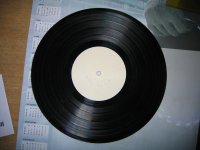PMA, do you know by any chance the wherabouts of that material and whether it was released on CD?Correct. I worked in Supraphon recording studios for some time, in the seventies, ....
I own a vinyl record of the Armstrong 1965 Prague concert, and also unreleased recordings from his visit to Prague.
You have extra tunes from that concert? I envy you!
Yes, and many gallons of sweat have been spend to find better and lower cost alternatives to those dreaded transformers, as witnessed by Bill Whitlock's InGenius balanced receivers.
Dreaded?
se
So no science all fashion , both of you would be wrong, so much for collective reasoning ...
,
So far it's still 2 to 1
Mono cartridge much ...?
No need, just sum L and R and a stereo cart will work perfectly fine on mono recordings, even those produced on a mono cutting lathe.
Dreaded?
se
Of course. Wouldn't you want a nice, cheap, small part that would perform as well or better than a heavy, expensive clunky piece of iron with lots of wire around it?
PMA, do you know by any chance the wherabouts of that material and whether it was released on CD?
You have extra tunes from that concert? I envy you!
I have a 25 cm 33 1/3 rpm vinyl with 9 tracks. It was pressed in a very limited number of copies, with blank label. For some reason, it was forbidden to place the record on the market. On side one, Louis speaks about roots of jazz and shows musical examples. Side 2 also contains several unreleased live recordings. You know there were 2 concerts when he visited Prague in 1965, and one small session in a Semafor theater, which resembled more a jazz club than a theater. My parents got that record from a former vice president of Supraphon.
Where are you from?
Attachments
Of course. Wouldn't you want a nice, cheap, small part that would perform as well or better than a heavy, expensive clunky piece of iron with lots of wire around it?
Oh yeah? We'll tell me, Jan, which of THAT's little bits of silicon provides any amount of galvanic isolation? Huh? Huh? Go on, tell me, Jan. I double dog dare ya!
se
What's that? Can't hear you, Jan. Cat got your tongue?
se
Steve, steve! Any designer worth his salt can do without the need for galvanic isolation (and I make an exception for tube guys, OTL remains a niche).
True, there are some that are not up to speed on grounding and differential stuff, and for them a transformer can be a good solution. But you don't need that!
Jan
I never tried to declare it as truth.
Just our opinion, to which we are entitled.
Patrick
Not on this thread! Either conform or be considered to be an evil one!
Steve, steve! Any designer worth his salt can do without the need for galvanic isolation (and I make an exception for tube guys, OTL remains a niche).
True, there are some that are not up to speed on grounding and differential stuff, and for them a transformer can be a good solution. But you don't need that!
In other words, "None of them do."
Anyway, that's fine if your design is all self-contained. But what about when you need to connect to a wide variety of other components?
se
How can you say that,? Competent engineers always have the situation well in hand, would never make such a 'mistake' ...

Sorry to butt in, Frank, but what you said jokingly above is much more true than you seem to think. The problem lies elsewhere - engineers will do a good job, then the accountans come and say no, we can't do that, that's too expensive, it will push our product outside its designated price niche. And hell, it don't even shine in the dark. Now, if you could translate that into a LED light show ... and drop the price by 50%, we can discuss it.
The lavish days of the 70ies are, alas, long gone, never to return. Remember, in those days, even mass manufacturers used to have discrete resistor tone and volume controls. Of the popular makes, to the best of my knowledge the last units to use that technology were Dual's CV 1600 and CV 1700, production ending in 1981. Price made tracking errors of 3 dB suddenly acceptable.
I see you folks are still battling the discrete vs. op amp theme. In my view, both can be put to good and bad use. A few op amp preamps, for example, even one proposed as a kit by the European electrnics journal "Elektor", made some awfully nice sounds.
By comparison, my own Philips "Black Tulip" AH280 preamp sure looks wildly well done, as one might expect from such a company's best ever top of the line series. Great regulated power supplies, fully complementary from input to output, look to die for, very solid Japanese (Eh? Japanese? Yep!) manufacturing, FET inputs, in short, the works.
Too bad it screeches at you, it almost literally screams, practically killing the whole system (AH180 tuner and AH370 or AH380 power amps). No wonder it lived less than 3 years on the market, I'm suprised it held out that long. Exchange it for another contemporary preamp, such as say Marantz 3250 B, and you get to listen to some good music.
The difference is, quite literally, like comparing Pavel's line stage as a jet plane with that preamp, which would then come across as a skate board. Yet, Pavel's design is so much cheaper and easier to make.
Just using discrete guarantees absolutely nothing. In fact, just using whatever guarantees nothing.
In other words, "None of them do."
se
'Course not - you knew that before you asked the question.
But what about when you need to connect to a wide variety of other components?
se
What about it? Didn't we solve that decades ago?
Jan
Jan thanks for the initial info.
THAT Introduces an InGenius Way to Eliminate Noise
I’d love to see some technical data and block architecture
Is there any group buy under plan for these?
What about it? Didn't we solve that decades ago?
For a home system, maybe.
Certainly not for a prof multi module console (one of the main drives for placing the A/D as close to the signal source as possible)
George
I’d love to see some technical data and block architecture
Here they are.
http://www.thatcorp.com/datashts/THAT_1200-Series_Datasheet.pdf
http://www.thatcorp.com/datashts/THAT_1200-Demo_Datasheet.pdf
George
What about it? Didn't we solve that decades ago?
How did we solve that? Is everything out there designed and built by the same people?
se
Howard, to my knowledge, Studers were the only machines that did not use HF time constant adjustment like the rest of the industry, but used sort of tone control adjustment in tandem with fixed T to bring HF in line. Did you change that one?I had to .... modify all of the repro equalizers in them to make them accurate.
Part of Harman empire and selling digital consoles to their old clients ..A once great company that got too full of itself and where are they today?
- Status
- Not open for further replies.
- Home
- Member Areas
- The Lounge
- John Curl's Blowtorch preamplifier part II

